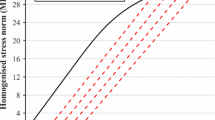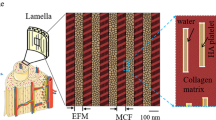Abstract
This work develops a model for the mechanical response of trabecular bone including plasticity, damage and fracture. It features a resultant lamellar orientation that captures trabecular strut anisotropic elasticity, and introduces asymmetric J2 plasticity with isotropic hardening to capture evolving strut tensile and compressive dissipative properties. A continuum compatibility based damage and fracture criterion is also proposed to model fracture surface generation. We investigated fracture of a trabecular bone network under a compressive load, for which failure modes of both tension and compression were identified at the strut level. The predicted trabecular network response was found to fall within the range of experimental results reported in literature. We also investigated the response of idealized struts under compression, tension and bending using our model. Individual struts were found to exhibit micro-buckling under compression and micro-necking under tension. These instabilities are however masked by the multiplicity and complexity of strut orientations at the trabecular network level.















Similar content being viewed by others
References
Rho J-Y, Kuhn-Spearing L, Zioupos P (1998) Mechanical properties and the hierarchical structure of bone. Med Eng Phys 20:92–102
Niebur GL, Feldstein MJ, Yuen JC, Chen TJ, Keaveny TM (2000) High-resolution finite element models with tissue strength asymmetry accurately predict failure of trabecular bone. J Biomech 33:1575–1583
Niebur GL, Keaveny TM (2010) Computational modeling of trabecular bone. Comput Model Biomech 305:277–306
Cummings SR, Karpf DB, Harris F, Genant HK, Ensrud K, Lacroix AZ, Black DM (2002) Improvement in spine bone density and reduction in risk of vertebral fractures during treatment with antiresorptive drugs. Am J Med 112:281–289
Stölken J, Kinney J (2003) On the importance of geometric nonlinearity in finite-element simulations of trabecular bone failure. Bone 33:494–504
Bayraktar HH, Keaveny TM (2004) A computational investigation of the nonlinear behavior of human trabecular bone. Transactions of the 12th annual pre-ORS symposium on computational methods in orthopaedic biomechnics
Ritchie RO, Buehler MJ, Hansma P (2009) Plasticity and toughness in bone. Phys Today 62:41–47
Chevalier Y, Pahr D, Allmer H, Charlebois M, Zysset P (2007) Validation of a voxel-based FE method for prediction of the uniaxial apparent modulus of human trabecular bone using macroscopic mechanical tests and nanoindentation. J Biomech 40:3333–3340
Yeh OC, Keaveny TM (2001) Relative roles of microdamage and microfracture in the mechanical behavior of trabecular bone. J Orthop Res 19:1001–1007
van Rietbergen B, Weinans H, Huiskes R, Odgaard A (1995) A new method to determine trabecular bone elastic properties and loading using micromechanical finite-element models. J Biomech 28:69–81
Bevill G, Keaveny TM (2009) Trabecular bone strength predictions using finite element analysis of micro-scale images at limited spatial resolution. Bone 44:579–584
Harrison NM, McDonnell P, Mullins L, Wilson N, O’Mahoney D, McHugh PE (2013) Failure modelling of trabecular bone using a non-linear combined damage and fracture voxel finite element approach. Biomech Model Mechanobiol 12:225–241
Keaveny TM, Morgan EF, Niebur GL, Yeh OC (2001) Biomechanics of trabecular bone. Annu Rev Biomed Eng 3:307–333
Akhtar R, Eichhorn S, Mummery P (2006) Microstructure-based finite element modelling and characterisation of bovine trabecular bone. J Bionic Eng 3:3–9
Gong H, Wang L, Fan Y, Zhang M, Qin L (2015) Apparent-and tissue-level yield behaviors of l4 vertebral trabecular bone and their associations with microarchitectures. Ann Biomed Eng 44:1–20
Sanyal A, Keaveny TM (2013) Biaxial normal strength behavior in the axial-transverse plane for human trabecular boneeffects of bone volume fraction, microarchitecture, and anisotropy. J Biomech Eng 135:121010
Sanyal A, Gupta A, Bayraktar HH, Kwon RY, Keaveny TM (2012) Shear strength behavior of human trabecular bone. J Biomech 45:2513–2519
Tsouknidas A, Maliaris G, Savvakis S, Michailidis N (2015) Anisotropic post-yield response of cancellous bone simulated by stress–strain curves of bulk equivalent structures. Comput Methods Biomech Biomed Engin 18:839–846
Lü L, Meng G, Gong H, Zhu D, Gao J, Fan Y (2015) Tissue level microstructure and mechanical properties of the femoral head in the proximal femur of fracture patients. Acta Mech Sin 31:1–9
Wolfram U, Gross T, Pahr DH, Schwiedrzik J, Wilke H-J, Zysset PK (2012) Fabric-based tsai-wu yield criteria for vertebral trabecular bone in stress and strain space. J Mech Behav Biomed Mater 15:218–228
Nawathe S, Juillard F, Keaveny TM (2013) Theoretical bounds for the influence of tissue-level ductility on the apparent-level strength of human trabecular bone. J Biomech 46:1293–1299
Bevill G, Eswaran SK, Gupta A, Papadopoulos P, Keaveny TM (2006) Influence of bone volume fraction and architecture on computed large-deformation failure mechanisms in human trabecular bone. Bone 39:1218–1225
Bayraktar HH, Morgan EF, Niebur GL, Morris GE, Wong EK, Keaveny TM (2004) Comparison of the elastic and yield properties of human femoral trabecular and cortical bone tissue. J Biomech 37:27–35
Guillén T, Zhang Q-H, Tozzi G, Ohrndorf A, Christ H-J, Tong J (2011) Compressive behaviour of bovine cancellous bone and bone analogous materials, microct characterisation and Fe analysis. J Mech Behav Biomed Mater 4:1452–1461
Gross T, Pahr D (2013) Influence of mesh size and element type on apparent yield properties of microct based finite element models of human trabecular bone. Comput Vis Med Image Process IV VIPIMAGE 2013:415
Kelly N, McGarry JP (2012) Experimental and numerical characterisation of the elasto-plastic properties of bovine trabecular bone and a trabecular bone analogue. J Mech Behav Biomed Mater 9:184–197
Schwiedrzik J, Gross T, Bina M, Pretterklieber M, Zysset P, Pahr D (2015) Experimental validation of a nonlinear \(\mu \)fe model based on cohesive-frictional plasticity for trabecular bone. Int J Numer Method Biomed Eng 32:1–12
Mercer C, He M, Wang R, Evans A (2006) Mechanisms governing the inelastic deformation of cortical bone and application to trabecular bone. Acta Biomater 2:59–68
Verhulp E, Van Rietbergen B, Müller R, Huiskes R (2008) Micro-finite element simulation of trabecular-bone post-yield behaviour-effects of material model, element size and type. Comput Methods Biomech Biomed Engin 11:389–395
Shi X, Liu XS, Wang X, Guo XE, Niebur GL (2010) Effects of trabecular type and orientation on microdamage susceptibility in trabecular bone. Bone 46:1260–1266
Hambli R (2013) Micro-CT finite element model and experimental validation of trabecular bone damage and fracture. Bone 56:363–374
Martin R, Ishida J (1989) The relative effects of collagen fiber orientation, porosity, density, and mineralization on bone strength. J Biomech 22:419–426
Benecke G, Kerschnitzki M, Fratzl P, Gupta HS (2011) Digital image correlation shows localized deformation bands in inelastic loading of fibrolamellar bone. J Mater Res 24:421–429
Jungmann R, Szabo M, Schitter G, Tang RY-S, Vashishth D, Hansma P, Thurner P (2011) Local strain and damage mapping in single trabeculae during three-point bending tests. J Mech Behav Biomed Mater 4:523–534
Gupta HS, Seto J, Wagermaier W, Zaslansky P, Boesecke P, Fratzl P (2006) Cooperative deformation of mineral and collagen in bone at the nanoscale. Proc Natl Acad Sci USA 103:17741–17746
Thurner P, Erickson B, Jungmann R, Schriock Z, Weaver J, Fantner G, Schitter G, Morse D, Hansma P (2007) High-speed photography of compressed human trabecular bone correlates whitening to microscopic damage. Eng Fract Mech 74:1928–1941
Aerssens J, Boonen S, Lowet G, Dequeker J (1998) Interspecies differences in bone composition, density, and quality: potential implications for in vivo bone research. Endocrinology 139:663–670
Ingomar Jäger PF (2000) Mineralized collagen fibrils: a mechanical model with a staggered arrangement of mineral particles. Biophys J 79:1737–1746
Kabel J, van Rietbergen B, Dalstra M, Odgaard A, Huiskes R (1999) The role of an effective isotropic tissue modulus in the elastic properties of cancellous bone. J Biomech 32:673–680
Zysset P, Goulet R, Hollister S (1998) A global relationship between trabecular bone morphology and homogenized elastic properties. J Biomech Eng 120:640–646
Fantner GE, Hassenkam T, Kindt JH, Weaver JC, Birkedal H, Pechenik L, Cutroni Ja, Cidade GaG, Stucky GD, Morse DE, Hansma PK (2005) Sacrificial bonds and hidden length dissipate energy as mineralized fibrils separate during bone fracture. Nat Mater 4:612–616
Fantner GE, Oroudjev E, Schitter G, Golde LS, Thurner P, Finch MM, Turner P, Gutsmann T, Morse DE, Hansma H, Hansma PK (2006) Sacrificial bonds and hidden length: unraveling molecular mesostructures in tough materials. Biophys J 90:1411–1418
Gupta HS, Wagermaier W, Zickler G a, Raz-Ben Aroush D, Funari SS, Roschger P, Wagner HD, Fratzl P (2005) Nanoscale deformation mechanisms in bone. Nano Lett 5:2108–2111
Garcia D, Zysset PK, Charlebois M, Curnier A (2009) A three-dimensional elastic plastic damage constitutive law for bone tissue. Biomech Model Mechanobiol 8:149–165
Bayraktar HH, Gupta A, Kwon RY, Papadopoulos P, Keaveny TM (2005) The modified super-ellipsoid yield criterion for human trabecular bone. J Biomech Eng 126:677–684
Cazacu O, Barlat F (2004) A criterion for description of anisotropy and yield differential effects in pressure-insensitive metals. Int J Plast 20:2027–2045
Terrier A, Rakotomanana R, Ramaniraka A, Leyvraz P (1997) Adaptation models of anisotropic bone. Comput Methods Biomech Biomed Engin 1:47–59
Fan Z, Rho J, Swadener J (2004) Three-dimensional finite element analysis of the effects of anisotropy on bone mechanical properties measured by nanoindentation. J Mater Res 19:114–123
Hill R (1948) A theory of the yielding and plastic flow of anisotropic metals. Proc R Soc Lond Ser A 193:281–297
Belytschko T, Liu W, Moran B, Elkhodary K (2013) Nonlinear finite elements for continua and structures. Wiley, Chichester
Engelen RAB, Fleck NA, Peerlings RHJ, Geers MGD (2006) An evaluation of higher-order plasticity theories for predicting size effects and localisation. Int J Solids Struct 43:1857–1877
Vernerey FJ, Liu WK, Moran B, Olson G (2006) A micromorphic model for the multiple scale failure of heterogeneous materials. J Mech Phys Solids 56:1320–1347
Vernerey FJ, Liu WK, Moran B (2007) Multiscale micromorphic theory for hierarchical materials. J Mech Phys Solids 55:2603–2651
Lai WM, Rubin DH, Rubin D, Krempl E (2009) Introduction to continuum mechanics. Butterworth-Heinemann, New York
Elkhodary K, Zikry M (2011) A fracture criterion for finitely deforming crystalline solids—the dynamic fracture of single crystals. J Mech Phys Solids 59:2007–2022
Elkhodary K, Zikry M (2012) Dynamic crack nucleation and propagation in polycrystalline aluminum aggregates subjected to large inelastic deformations. Int J Fract 175:95–108
Kröner E (1981) Continuum theory of defects. In: Balian R (ed) Proceedings of summer school on the physics of defects. North-Holland, Amsterdam, Les Houches, Fr., pp 215–315
Hibbit H, Karlsson B, Sorensen P (2007) ABAQUS analysis user’s manual, 6.7, ABAQUS. http://scholar.google.com/scholar?q=Hibbitt+ABAQUS++2007&btnG=&hl=en&as_sdt=0,14#4
Song J, Wang H, Belytschko T (2008) A comparative study on finite element methods for dynamic fracture. Comput Mech 42:239–250
Ulrich D, Rietbergen BV, van Rietbergen B, Weinans H, Rüegsegger P (1998) Finite element analysis of trabecular bone structure: a comparison of image-based meshing techniques. J Biomech 31:1187–1192
Zhang Y, Hughes T, Bajaj C (2010) An automatic 3D mesh generation method for domains with multiple materials. Comput Methods Appl Mech Eng 199:405–415
Zhang Y, Bajaj C, Sohn B (2005) 3D finite element meshing from imaging data. Comput Methods Appl Mech Eng 194:5083–5106
Zhang Y, Bajaj C (2006) Adaptive and quality quadrilateral/hexahedral meshing from volumetric data. Comput Methods Appl Mech Eng 195:942–960
Zhang Y, Xu G, Bajaj C (2006) Quality meshing of implicit solvation models of biomolecular structures. Comput Aided Geom Des 23:510–530
Zhang Y, Bajaj C, Xu G (2009) Surface smoothing and quality improvement of quadrilateral/hexahedral meshes with geometric flow. Commun Numer Methods Eng 25:1–18
Martin R, Boardman D (1993) The effects of collagen fiber orientation, porosity, density, and mineralization on bovine cortical bone bending properties. J Biomech 26:1047–1054
Goldstein SA, Wilson DL, Sonstegard DA, Matthews LS (1983) The mechanical properties of human tibial trabecular bone as a function of metaphyseal location. J Biomech 16:965–969
Acknowledgments
D.T. O’Connor would like acknowledge the National Physical Sciences Consortium (NPSC) and Argonne National Laboratory for their partial support. K.I. Elkhodary gratefully acknowledges the financial and technical support received from AUC for this research. J. Qian and Y. Zhang were supported in part by NSF CAREER Award OCI-1149591.
Author information
Authors and Affiliations
Corresponding author
Rights and permissions
About this article
Cite this article
O’Connor, D.T., Elkhodary, K.I., Fouad, Y. et al. Modeling orthotropic elasticity, localized plasticity and fracture in trabecular bone. Comput Mech 58, 423–439 (2016). https://doi.org/10.1007/s00466-016-1301-3
Received:
Accepted:
Published:
Issue Date:
DOI: https://doi.org/10.1007/s00466-016-1301-3




